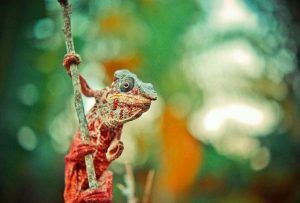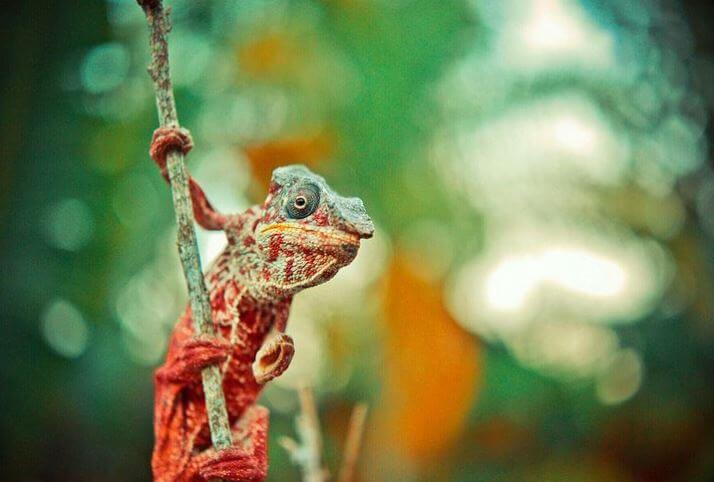How frequent do chameleons eat
How frequent do chameleons eat: Chameleons, with their mesmerizing ability to change colors and their unique physical adaptations, have long captivated the imagination of nature enthusiasts and researchers alike. These remarkable reptiles, belonging to the family Chamaeleonidae, are renowned for their exceptional camouflage skills and striking appearances. With over 200 recognized species scattered across various regions of the world, chameleons exhibit a remarkable diversity in size, coloration, and habitat preferences.
Brief Overview of Chameleons as Fascinating Reptiles
Chameleons are predominantly arboreal creatures that inhabit a range of ecosystems such as rainforests, deserts, and savannahs. Their distinctive features include bulging eyes that can move independently from each other, a prehensile tail for gripping branches with ease, and zygodactylous feet specially adapted for climbing.
These adaptations allow chameleons to navigate their surroundings with tremendous agility while exhibiting astounding visual acuity. Beyond their striking physical attributes, chameleons also possess a truly extraordinary ability – the capacity to change colors rapidly.
The color-changing process is not only used for camouflage but also for communication purposes such as displaying territorial aggression or mating interest. This incredible display is achieved through specialized cells called chromatophores located beneath the reptile’s transparent outer skin layer.
Importance of Understanding Their Dietary Habits
To fully comprehend chameleon behavior and optimize their care in captivity or conservation efforts in the wild, an understanding of their dietary habits is crucial. Chameleons are primarily insectivorous creatures with a diet consisting mostly of small insects like crickets, flies, grasshoppers, and spiders. By unraveling the complexities of chameleon feeding patterns—specifically how often they eat—we gain insights into their energy requirements and metabolism.
This knowledge enables us to provide appropriate nutrition and care, ensuring the overall health and well-being of these captivating reptiles. Moreover, understanding chameleon dietary habits aids conservationists in designing effective habitat management plans that support their natural prey availability, thus safeguarding their populations in the wild.
In the subsequent sections of this article, we will delve into the general feeding patterns of chameleons, explore factors that influence their feeding frequency, discuss species-specific dietary requirements, examine variations among different chameleon species, and shed light on their unique feeding behaviors. Through this comprehensive exploration, we aim to unravel the intricacies of how often chameleons consume food and gain a deeper appreciation for these fascinating creatures’ nutritional needs.
General Feeding Patterns of Chameleons
Overview of chameleon species and their diverse habitats
 Chameleons, an extraordinary group of reptiles belonging to the family Chamaeleonidae, exhibit remarkable diversity in terms of species and habitats. They are primarily found in Africa, Madagascar, and parts of Asia and Europe. Within these regions, they occupy a wide range of environments including rainforests, deserts, savannas, and mountains.
Chameleons, an extraordinary group of reptiles belonging to the family Chamaeleonidae, exhibit remarkable diversity in terms of species and habitats. They are primarily found in Africa, Madagascar, and parts of Asia and Europe. Within these regions, they occupy a wide range of environments including rainforests, deserts, savannas, and mountains.
Each chameleon species has evolved to adapt to specific ecological niches within these habitats. For instance, the veiled chameleon (Chamaeleo calyptratus) is native to the mountainous regions of Yemen and Saudi Arabia.
Its preferred habitat consists of dense vegetation where it can find ample cover for hunting insects and protection from predators. On the other hand, the panther chameleon (Furcifer pardalis), endemic to Madagascar’s rainforests, thrives amidst lush vegetation with its remarkable color-changing ability aiding in camouflage.
Explanation of how chameleons are primarily insectivorous
When it comes to feeding habits, chameleons are predominantly insectivorous creatures. Their diet mainly consists of various invertebrates such as crickets, grasshoppers, flies, moths, spiders, and even smaller lizards.
The unique anatomy of their jaws allows them to possess an exceptional ability for precise targeting when capturing prey. Chameleons have highly muscular tongues that can rapidly extend beyond their body length with impressive accuracy.
This specialized projectile tongue enables them to catch unsuspecting insects from a distance by shooting it out at incredible speeds. Once captured by adhesive saliva on their tongues’ tip surface area or intercepted mid-air with lightning-fast reflexes while climbing or walking along branches or foliage.
Discussion on the frequency and quantity of meals
The frequency and quantity of chameleon feeding depend on several factors, including the individual’s age, size, and metabolism. Generally, adult chameleons feed less often than juveniles due to their slower metabolic rates.
Juvenile chameleons are known to have higher energy requirements for growth and development. In terms of meal frequency, adult chameleons typically eat every two to three days.
However, specific species may exhibit slight variations in this feeding schedule. Smaller insectivorous species may require more frequent meals to sustain their higher metabolic demands, while larger chameleon species may consume larger quantities during each feeding session but with longer intervals between meals.
It is important for chameleon owners and enthusiasts to understand the optimal feeding patterns and adjust their husbandry practices accordingly. Providing a balanced diet that replicates their natural insectivorous preferences ensures these captivating reptiles remain healthy and vibrant in captivity.
Factors Influencing Chameleon Feeding Frequency
Age and Size: Differences in feeding patterns between juvenile and adult chameleons
 When it comes to chameleon feeding habits, age and size play crucial roles in determining their frequency of meals. Juvenile chameleons, being smaller and more energetically active than their adult counterparts, exhibit higher feeding rates. As young chameleons are rapidly growing and developing, they require a constant influx of nutrients to support their metabolic demands.
When it comes to chameleon feeding habits, age and size play crucial roles in determining their frequency of meals. Juvenile chameleons, being smaller and more energetically active than their adult counterparts, exhibit higher feeding rates. As young chameleons are rapidly growing and developing, they require a constant influx of nutrients to support their metabolic demands.
Therefore, juveniles often consume small meals multiple times throughout the day. On the other hand, adult chameleons generally exhibit lower feeding frequencies due to their comparatively larger body size and reduced metabolic rate.
As they reach maturity, their growth rate slows down significantly, resulting in decreased energy requirements. Consequently, adult chameleons adjust their feeding habits accordingly by consuming larger meals but less frequently.
Relationship between body size and metabolic rate
The relationship between body size and metabolic rate is a critical factor influencing chameleon feeding frequency. Chameleons with smaller body sizes have faster metabolisms relative to larger individuals. This implies that smaller species or younger individuals within a species tend to have higher metabolic rates compared to larger or more mature chameleons.
A faster metabolic rate necessitates a higher intake of food to sustain energy production within the body systems. Consequently, smaller-sized chameleons typically feed more frequently than their larger counterparts due to their increased energy demands resulting from heightened metabolism.
Environmental Conditions: Impact of temperature on digestion and metabolism in chameleons; Seasonal variations in feeding behavior due to changes in prey availability
Environmental conditions hold considerable sway over the feeding frequency of chameleons as well. Temperature plays a pivotal role in regulating digestion and metabolism within these reptiles’ bodies.
Warmer temperatures generally promote faster metabolic rates, leading to increased energy requirements. As a result, chameleons in warmer climates or seasons tend to exhibit higher feeding frequencies compared to those inhabiting cooler regions.
Furthermore, seasonal variations in prey availability also influence chameleon feeding behavior. In certain ecosystems, prey populations fluctuate with changing seasons, impacting the availability of food sources.
During periods of abundance, chameleons may increase their feeding frequency to capitalize on the readily available prey. Conversely, during lean periods when prey is scarce, chameleons may reduce their feeding rates accordingly in order to conserve energy and adapt to the limited resource availability.
By considering these factors—age and size differentials, the relationship between body size and metabolic rate, as well as the impact of environmental conditions— one can gain a deeper understanding of the intricate mechanisms behind chameleon feeding frequency. These adaptive strategies enable these captivating reptiles to survive and thrive in diverse habitats while effectively managing their nutritional needs.
How frequent do chameleons eat: Species-Specific Dietary Requirements
Overview of different chameleon species’ dietary preferences
How frequent do chameleons eat: Chameleon species exhibit a remarkable diversity in their dietary preferences, reflecting their adaptation to specific environments. Understanding these variations provides valuable insights into the feeding habits of these captivating reptiles. One such species with notable dietary flexibility is the Veiled chameleon (Chamaeleo calyptratus).
With omnivorous tendencies, they do not solely rely on insects but also incorporate plant matter into their diet. This versatile approach allows them to exploit a wider range of food sources, enhancing their chances of survival in diverse habitats.
On the other hand, Panther chameleons (Furcifer pardalis), renowned for their vibrant coloration and striking patterns, have a more specialized diet. These magnificent creatures are primarily insectivorous, relying solely on a variety of arthropods for sustenance.
Their strong jaws and agile tongues enable them to swiftly capture fast-moving prey such as crickets, grasshoppers, and even small lizards. This insect-centric diet ensures that Panther chameleons obtain the protein-rich nourishment necessary for growth and maintenance.
The divergence in dietary preferences between Veiled and Panther chameleons underscores the adaptability of different chameleon species to varying ecological niches. While some species possess broader palates that encompass both animal and plant-based sustenance, others focus exclusively on capturing insects to satisfy their nutritional requirements.
Veiled Chameleons (Chamaeleo calyptratus) – Omnivorous Tendencies
Veiled chameleons (Chamaeleo calyptratus) are known for their ability to consume a diverse range of food items due to their omnivorous tendencies. In addition to hunting and devouring insects like crickets, flies, grasshoppers, and moths, they also incorporate various plant matter into their diet. These resourceful reptiles often feed on leaves, flowers, and fruits of different plants found in their native habitats.
This dietary flexibility allows Veiled chameleons to adapt to changing food availability and exploit a wider range of nutritional resources. While their insect consumption provides essential protein and fat sources necessary for energy production and growth, the inclusion of plant material supplements their nutritional needs with essential vitamins and minerals.
Veiled chameleons have been observed engaging in selective herbivory, showing preference for certain plant species rich in nutrients. By consuming both animal and plant matter, these chameleons demonstrate a remarkable ability to adapt their feeding habits according to resource availability.
The omnivorous tendencies of Veiled chameleons showcase the evolutionary advantage of being flexible in food choices. This trait allows them to thrive in different environments where both animal prey and suitable vegetation may not always be abundant or readily available.

Panther Chameleons (Furcifer pardalis) – Insectivorous Diet
How frequent do chameleons eat: Panther chameleons (Furcifer pardalis) are renowned for their striking beauty as well as their highly specialized insectivorous diet. These colorful creatures preferentially feed on an array of insects that abound in their native rainforest habitats.
Their hunting prowess relies on a combination of camouflage techniques, swift tongue strikes, and exceptional vision. Panther chameleons spend significant amounts of time perched on branches or foliage waiting patiently for unsuspecting prey to come within striking range.
With acute eyesight capable of detecting even the slightest movements, they accurately target insects such as grasshoppers, crickets, flies, spiders, and caterpillars from considerable distances. Once located, Panther chameleons employ lightning-fast tongue projection to capture prey with astonishing precision.
By specializing in an insectivorous diet exclusively, Panther chameleons have honed their hunting skills and adapted to be highly efficient predators. Their dietary reliance on insects ensures a constant supply of protein-rich meals, which are essential for growth, reproduction, and overall health.
Chameleon species exhibit distinct dietary preferences that are closely linked to their ecological adaptations. Veiled chameleons display omnivorous tendencies, allowing them to consume both animal prey and plant matter for a diverse range of nutrients.
In contrast, Panther chameleons have evolved as specialized insectivores, relying solely on prey such as insects to fulfill their nutritional requirements. These intriguing dietary variations exemplify the remarkable diversity within the world of chameleons and highlight the intricate balance between their feeding habits and survival strategies in diverse habitats.
Frequency Variation Among Different Chameleon Species
Comparison between Arboreal and Terrestrial Species
How frequent do chameleons eat: Arboreal chameleon species, such as the panther chameleon (Furcifer pardalis), exhibit a higher feeding frequency compared to their terrestrial counterparts. This disparity can be attributed to the increased energy expenditure required during climbing and navigating their vertical habitats.
Arboreal chameleons are well adapted to life in trees, with long limbs, prehensile tails, and specialized feet for gripping branches. This means that they must actively hunt for prey while simultaneously maintaining balance and stability in their arboreal environment.
As a result, they have a greater demand for energy intake to sustain their heightened activity levels. On the other hand, terrestrial chameleon species have lower feeding frequencies due to reduced energy requirements associated with living on the ground.
These species, like the veiled chameleon (Chamaeleo calyptratus), inhabit shrubs, bushes, or even desert environments where climbing is less necessary for survival. They tend to have shorter limbs and lack some of the adaptations seen in arboreal species.
Consequently, terrestrial chameleons do not expend as much energy on locomotion or hunting since they rely more on camouflage and ambush strategies to capture prey. It is important to note that while there is a general trend of higher feeding frequency among arboreal species and lower feeding frequency among terrestrial species, there can be variations within each group depending on factors such as specific habitat conditions and availability of prey sources.
Feeding Frequencies in Arboreal Chameleons
 Arboreal chameleons possess remarkable agility when it comes to hunting. Their high feeding frequency reflects their need for sustained energy intake due to increased activity levels associated with climbing trees. These chameleons often consume small insects such as crickets, grasshoppers, and flies.
Arboreal chameleons possess remarkable agility when it comes to hunting. Their high feeding frequency reflects their need for sustained energy intake due to increased activity levels associated with climbing trees. These chameleons often consume small insects such as crickets, grasshoppers, and flies.
Multiple small meals throughout the day better accommodate their energetic demands. Arboreal chameleons are known to forage during both day and night, taking advantage of the different insect populations active at various times.
Furthermore, arboreal chameleons have the ability to spot prey from considerable distances due to their excellent vision and color perception. This visual acuity enables them to efficiently track and capture fast-moving insects.
They also employ their projectile tongues with precision, extending them rapidly towards unsuspecting prey. These behaviors contribute to a higher feeding frequency as they consistently search for food sources while maintaining their position within the dense foliage of trees.
How frequent do chameleons eat: Feeding Frequencies in Terrestrial Chameleons
In contrast to arboreal chameleons, terrestrial species exhibit lower feeding frequencies owing to reduced energy requirements associated with ground-dwelling lifestyles. Terrestrial chameleons typically consume larger insects, such as beetles and grasshoppers, which provide more substantial energy intake per meal compared to the smaller insects favored by arboreal species.
This allows them to sustain themselves on fewer meals per day. Terrestrial chameleons often rely on camouflage techniques rather than actively pursuing prey.
Their color-changing abilities come into play as they blend into their surroundings, remaining motionless until an opportunity arises for an opportunistic strike at passing prey items. By minimizing movement and energy expenditure between meals, terrestrial chameleons can maintain lower feeding frequencies without compromising their overall survival or nutritional needs.
It is evident that there is a notable variation in feeding frequencies among different chameleon species based on their ecological niche and lifestyle adaptations. Arboreal species exhibit a higher feeding frequency due to increased energy expenditure associated with climbing and maintaining balance in tree habitats.
In contrast, terrestrial species have lower feeding frequencies as they rely more on camouflage strategies and consume larger prey items that offer greater energy content per meal. Understanding these differences in feeding behavior helps us appreciate the diverse ways chameleons have evolved to thrive in their respective environments.
To sum up how frequent do chameleons eat
Chameleons exhibit a range of unique feeding behaviors that highlight their exceptional evolutionary adaptations. From their incredible hunting techniques involving projectile tongues and camouflage strategies, to their ingenious drinking habits, these reptiles demonstrate remarkable versatility in obtaining food and hydration. Their ability to blend seamlessly with their surroundings and launch swift attacks with precision is a testament to the fascinating complexities of nature.
Understanding these distinctive feeding behaviors not only enhances our knowledge of chameleons but also deepens our appreciation for the intricacies of the natural world. So let us marvel at the wonders of these fascinating creatures and continue to explore the secrets they hold within their captivating lifestyles.
Further Reading:
- Best Turtle Substrate For Your Pet Tank
- Coconut substrate for chameleons
- Caught my Chameleon eating moss


